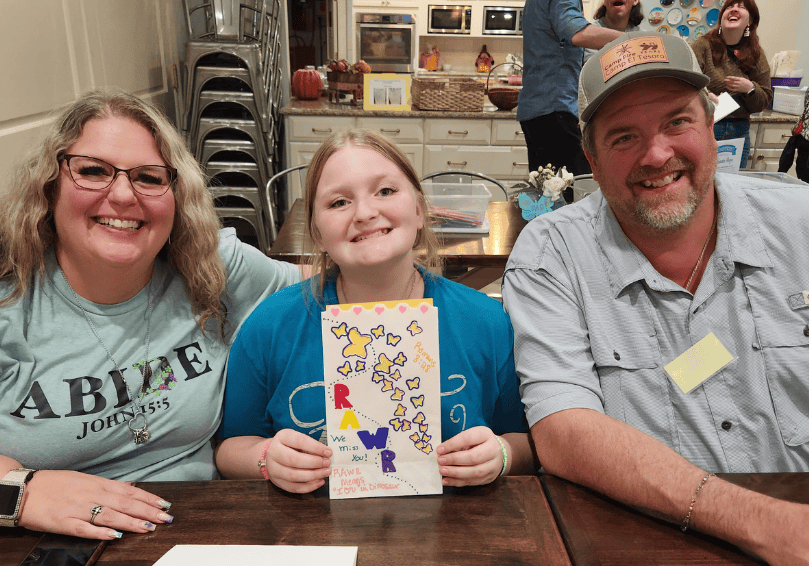Sometimes telling our story or expressing our feelings can be difficult. These activities help children communicate with family members in a creative way. As always, we’d love to see and hear how you and your family are doing these activities at home together! Email your photos and thoughts about the activities to dana@thewarmplace.org.
Tell Your Story Puppets: Ages 3-8
Supplies: Paper bag or sock, scissors, and glue or tape. Décor items for puppets: yarn for hair, paper shapes for the mouth/eyes/cheeks/nose, and paper or material for clothes. Top it off with extra decor elements such as sequins, buttons, stickers, puff balls, or anything you might have around the house. Note: You can do the whole puppet with crayons or markers if desired!

You can use several household items for the base of your puppet, like a paper bag or lunch bag. You can also use a sock. (You know you have a onesie because the dryer ate the other one!) For decoration, you can use just about anything you find in your home including the backyard. Have children put a face on the top folded section of their bag or sock. They can also put hair on with yarn or string and put clothes on the long part if desired. Children can draw or glue the pieces. Allow a little time for the glue to set. Each family member can make a puppet if desired. Children can talk to each other or to you through their puppets. You might ask questions such as:
How are you feeling today?
What do you miss most about your love one who died?
What do you remember most about the day your loved one died?
What is something you are worried about right now?
You can also use this activity to ask fun or lighthearted question to spark conversation such as “What do you want for dinner?”
Chain of Events: Ages 9-12
Supplies: Strips of construction paper (any kind of paper will do), glue/tape/staples, and markers or any writing utensils.
It is important mark experiences by naming, describing, and sharing facts and details about who has died, what we have lived through, and how to make sense of it.
Create a visual timeline of significant events that occurred before, during, and after the death of your loved one. Cut several strips of paper wide enough to write or draw on and long enough to make a circle. On the outside of each strip of paper, write an event that occurred before, during, or after the death of your loved one. On the backside, write the feelings associated with the event.
For example: When my mom was diagnosed with cancer, I felt ______. At the funeral, I felt ______. When I returned to school, I felt _______.
To make the chain, begin with one chain link. Add a touch of glue or tape to the end of a strip and loop the opposite end around. You can also use staples as well if you have those on hand. Place the ends together to create a ring. Loop another strip through the link and join it in the same fashion. Repeat attaching the remaining links/events and feelings. Other variations include writing memories on each link, your loved one’s favorite things, or things you want your loved one to know. Feel free to hang your chain up to share when completed.
Journaling: Ages 13+
Supplies: Paper and a writing utensil
Journaling is a great resource for all ages. It can help you process, explore your emotions and reduce stress. Another option is “joodling,” that is, drawing the journal prompts.
Find a comfortable place, take a breath and try to be present. Answer or joodle the prompt that speaks to you the most at that moment. You may discover things you never even knew about yourself. Be as real as you can be, because that is the healing process. Click here to view 50 journal prompts you might use to get started.
Examples of prompts:
1. I am grieving because…
2. I feel this way because…
3. I think most about…
4. When I go to bed, I think…
5. My most meaningful memory with you is…
Ask or Tell: The Whole Family
Supplies: One item to toss to family members. Examples: a pillow, small ball, ball of yarn, or a rolled up sock.
To play the game, make a circle. Someone starts the game by tossing the pillow to another. The person who receives the pillow must choose to “ask” or “tell”.
To “ask”, they must ask the one who tossed the pillow anything about the death in the family, or about the person who died, or about their feelings or thoughts about the death etc.
Some examples of asking questions could be:
“What was your favorite thing to do with your loved one?”
“What bothers you the most when you think about the death?”
To “tell”, they must share some information (of their choice) about the death in their family.
Some examples of “telling” could be:
“I wish I could have told my loved one ____.”
“I wish my loved knew ____ about me.”
“Sometimes I find it hard to sleep at night because I start thinking about my loved one.”
After the person asks or tells, they toss the pillow to someone else and take turns. You can choose other subjects to ask or tell about for variation.



